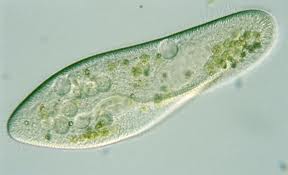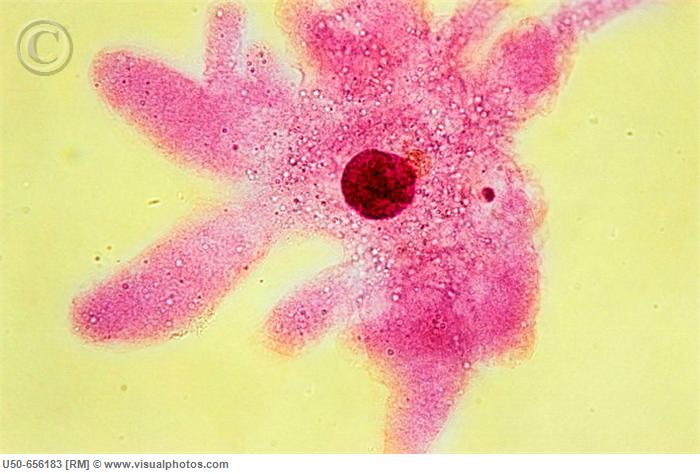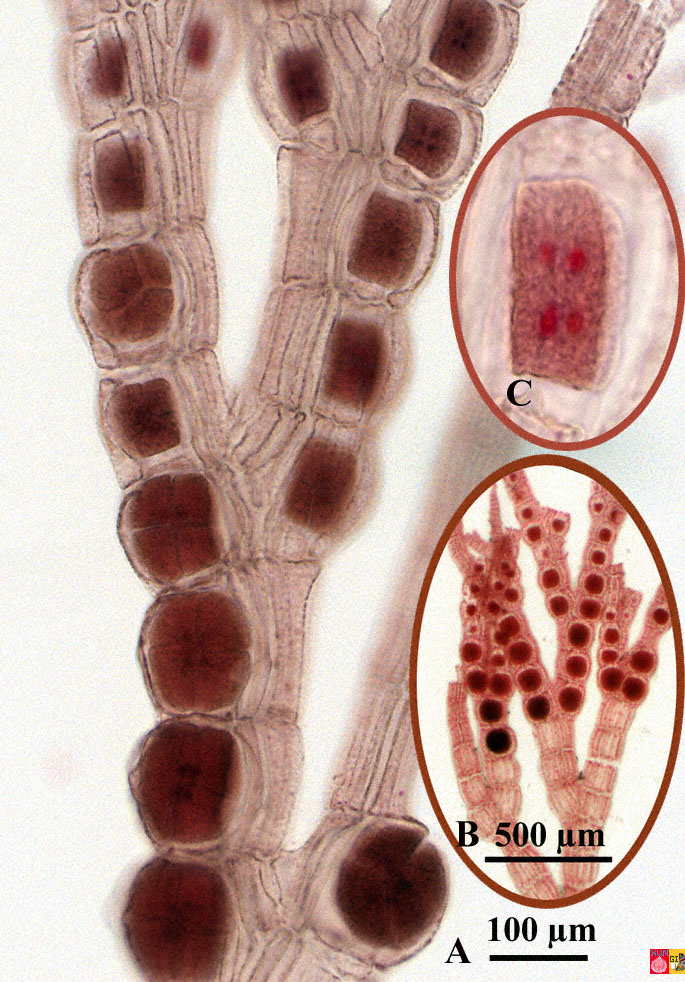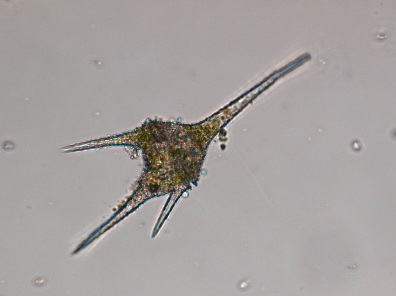Kingdom
Protista Phyla Groups
Introduction
to Kingdom Protista
The Kingdom
Protista includes an incredible diversity of different types of organisms,
including algae, protozoans, and slime molds. No one even knows how many species
there are, though estimates range between 65,000 to 200,000. All protists
are eukaryotes, complex cells with nuclear membranes and organelles like
mitochondria and chloroplasts. They can be either unicellular or multicellular,
and in this group we find the first inkling of what is to come in evolutionary
history, the union of eukaryotic cells into a colonial organism, where various
cell types perform certain tasks, communicate with one another, and together
function like a multicellular organism.
Two Major
Groups of Protists:
1.
Some protists are autotrophs,
a photosynthetic group of phyla referred to as the algae. Autotrophs manufacture
their own energy by photosynthesis or chemosynthesis. Algae use various
combinations of the major chlorophyll pigments, chlorophyll a, b, and c, mixed
with a wide array of other pigments that give some of them very distinctive
colors.
2. Some protists are heterotrophs,
a group of phyla called the protozoa. Heterotrophs get their energy by consuming
other organisms. Protists reproduce asexually by binary fission, and a few
species are capable of sexual reproduction. Many have very complex life cycles.
Protist
Characteristics:
Protists are so small that
they do not need any special organs to exchange gases or excrete wastes. They
rely on simple diffusion, the passive movement of materials from an area of high
concentration to an area of low concentration, to move gases and waste materials
in and out of the cell. Diffusion results from the random motion of molecules
(black and white marble analogy). This is a two-edged sword. They don't need to
invest energy in complex respiratory or excretory tissue. On the other hand,
diffusion only works if you're really small, so most protists are limited to
being small single cells. Their small size is also due to the inability of cilia
or flagella to provide enough energy to move a large cell through the water.
Protists eat by phagocytosis
- they engulf their food in their cell membrane, and pinch off a section of
membrane to form a hollow space inside the cell. This hollow space, now enclosed
by membranes, is called a vacuole. Vacuoles are handy little structures.
Protists also use them to store water, enzymes, and waste products. Paramecium
and many other protists have a complex type called a contractile vacuole, which
drains the cell of waste products and squirts them outside the cell.
All protists are aquatic.
Many protists can move through the water by means of flagella, or cilia, or
pseudopodia (= false feet). Cilia and flagella are tiny movable hairs. Motile
cells usually have one or two long flagella, or numerous shorter cilia. The
internal structure of cilia and flagella is basically the same. All of the
characteristics that this group shares are primitive traits, a perilous thing to
base any classification on, because convergent evolution may be responsible for
these superficial similarities. So the concept of the Kingdom Protista has been
justly criticized as a "taxonomic grab bag" for a whole bunch of
primitive organisms only distantly related to one another.
Protists are mainly defined
by what they are not - they are not bacteria or fungi, they are not plants or
animals. Protists gave rise to all other plants and animals. But where did
protists themselves come from? The earliest protists we can recognize in the
fossil record date back to about 1.2 billion years ago. We do not
know how the various groups of protists are related to one another. We assume
they arose from certain groups of bacteria, but which groups and when are still
investigating. Different phyla of protists are so unlike one another, many
probably evolved independently from completely different groups of bacteria.
Lynn Margulis recognizes nearly 50 different phyla of protists, or Protoctista,
as this kingdom is sometimes called. We will take a more conservative approach,
and focus on nine important phyla of protists.
Taxonomy Kingdom
Protista (Protoctista)
Protozoa = heterotrophic
protists:
Phylum
Sporozoa - (Plasmodium - "the protist that
causes malaria"u)
Algae = autotrophic
protists
Characteristics
of Phyla The
protozoa:
Phylum
Ciliophora (8,000 sp.,) Blepharisma, Paramecium
These ciliates move by means of
numerous small cilia. Ciliates are covered with these tiny little hairs
called cilia. This is their defining characteristic that sets them apart
from the other protists. They are complex little critters, with lots of
organelles and specialized structures. Many of them, like Paramecium, even
have little toxic threads or darts that they can discharge to defend
themselves. Typical ciliates you may see in lab include Paramecium and
Blepharisma.
Paramecium caudatum

Phylum
Sarcodina (over 300 sp.) - Amoeba, radiolaria, foraminifera
These ciliates have a most unusual
way of getting about. They extend part their body in a certain direction,
forming a pseudopod or false foot, and then flow into that extension (cytoplasmic
streaming). Many forms have a tiny shell made from organic or inorganic
material. They eat other protozoans, algae, and even tiny critters like
rotifers. Amoeba is a typical member of this phylum. Many sarcodines are
parasites, such as the species Entamoeba histolytica, which causes amoebic
dysentery. 10 million Americans are infected at any one time with some
form of parasitic amoeba, and up to half of the population in tropical
countries. Somewhat more unusual sarcodines are the Foraminiferans. These
"forams" can have fantastically sculptured shells, with prominent
spines. They extend cytoplasmic "podia" out along these spines,
which function in feeding and in swimming. Forams are so abundant in the
fossil record, and have such distinctive shapes, that they are widely used by
geologists as markers to identify different layers of rock. The famous white
cliffs of Dover are made up of billions of foraminiferan shells.
Amoeba proteus

Phylum
Sporozoa (3,900 sp.) - Plasmodium
This last group of protozoans is
non-motile, and parasitic. Non-motile refers to the fact that these
protists do not have cilia or flagella to help them move from place to
place. Instead, they "move" by means of using hosts.
They have very complex life cycles, involving intermediate hosts such as the
mosquito. They will begin their life cycle in the mosquito host, and
then when that infected mosquito bites a human, the parasitic protist is
transferred to the human. They form small resistant spores, small infective
bodies that are passed from one host to the next. To help them do this,
the Plasmodium has a cellular structure known as the apical complex.
This is what the Plasmodium uses to attach itself and penetrate into the
host's body.
The apical complex is the defining
feature of the sporozoans.
Plasmodium, the parasite that
causes malaria, is typical of this group. In more general terms, spores are
haploid reproductive cells that can develop directly into adults.
The apical complex is the defining
feature of the sporozoans.
Plasmodium, the parasite that
causes malaria, is typical of this group. In more general terms, spores are
haploid reproductive cells that can develop directly into adults.
In
regions where malaria is present, people who get infected
many times may have the disease but have few or no symptoms.
Also, how bad malaria symptoms are can vary
depending on your general health, what kind of malaria
parasite you have, and whether you still have your
spleen.
Common
symptoms of malaria
In the early
stages, malaria symptoms are sometimes similar to those of
many other infections caused by bacteria, viruses, or
parasites. Symptoms may include:
Symptoms may
appear in cycles and may come and go at different
intensities and for different lengths of time. But,
especially at the beginning of the illness, the symptoms may
not follow this typical pattern.
The cyclic
pattern of malaria symptoms is due to the
life
cycle of malaria parasites
 as they develop, reproduce, and are released from the red
blood
cells and liver
cells in the human body. This cycle of symptoms is also one
of the major indicators that you are infected with malaria.
as they develop, reproduce, and are released from the red
blood
cells and liver
cells in the human body. This cycle of symptoms is also one
of the major indicators that you are infected with malaria.
Other common
symptoms of malaria
Other common
symptoms of malaria include:
In rare cases,
malaria can lead to impaired function of the
brain
or spinal cord, seizures, or loss of consciousness.
Infection with
the Plasmodium falciparum parasite is usually more
serious and may become
life-threatening.
Malaria Treatment
During the 1600s,
Spanish Jesuits in Lima, Peru learned that bark extracts from a local tree in
the coffee family (Rubiaceae) called
"quina" (Cinchona
officinalis) could cure malaria. [Later it was discovered that this
"extract" contained the quinoline alkaloid called
quinine.] They
successfully used this extract on Countess Chinchon. According to O. Tippo and
W.L. Stern (Humanistic Botany, 1977),
the genus was named by Linnaeus
in honor of the countess, but spelled it Cinchona rather than "Chinchona.".
Today, quinine trees (C.
ledgeriana) are grown in plantations, although many synthetic antimalarial
drugs have been developed, such as
atabrine, chloroquine and primaquine. Some
strains of Plasmodium are resistant to many of the synthetic quinine
analogues, so natural
quinine is still used to this day. In fact, some people
take prophylactic doses of bitter quinine water (tonic) in the evenings,
usually mixed with gin or vodka.
Plasmodium falciparum



The algae:
Phylum
Phaeophyta (1,500 species, fr. Greek phaios = brown) - Fucus
This phylum contains the brown
algae, Sargassum, and the various species of kelp. Brown algae are the largest
protists, and are nearly all marine. Kelp blades can stretch up to 100 meters
long. Brown algae have thin blades with a central midrib or stipe. Like all
algae, their blades are thin because they lack the complex conductive tissues
of green plants (phloem), and must rely on simple diffusion, though some kelp
have phloem-like conducting cells in the midrib. Kelp form the basis of entire
ecosystems off the coast of California and in other cool waters. In the
Sargasso Sea, the Atlantic Ocean northeast of the Caribbean Islands, the brown
algae Sargassum forms huge floating mats, said in older days to trap entire
ships, holding them tight until the crew met a watery grave.
Sargassum


Phylum
Rhodophyta (fr. Greek rhodos = red, 4,000 sp.) - Polysiphonia
Like brown algae, the red algae
also contain complex forms, mostly marine, with elaborate life cycles.
Chloroplasts in this group show pigments very similar to those found in cyanobacteria, and ancient red algae may have engulfed these cyanobacteria as
endosymbionts. Red algae have many important commercial applications, such as
the agar used for culture plates. Its cell walls contain carrageenan, a
polysaccharide used in the manufacture of ice cream, paint, and cosmetics.
Polysiphonia

Phylum
Bacillariophyta (11,500 sp., many more fossil sp., fr. Latin bacillus = little
stick) - diatoms
Diatoms have a golden-brown
pigment. Some books still place them with the Chrysophyta, the golden-brown
algae, but they are now recognized as an entirely separate group. Diatoms have
odd little shells made of organic compounds impregnated with silica. The
fact that the shells are made of silica is unique to this group. The
shells fit over the top of one another like a little box. Diatoms usually
reform the lower shell after they divide This means they become smaller and
smaller, and when they become too small they leave their shells and fuse
through sexual reproduction into a larger size and start over again. They are
one of the most important organisms in both freshwater and marine food chains.
Diatoms are so abundant that the photosynthesis of diatoms accounts for a
large percentage of the oxygen added to the atmosphere each year from natural
sources. Their dead shells form huge deposits, that are mined for commercial
uses. Diatom shells are sold as diatomacious earth, and used in abrasives,
talcs, and chalk. Diatoms are so numerous that their shells form thick
deposits all over the world. A single quarry in Lompoc, California, yields
over 270,000 metric tons per year. One bed in the Santa Monica Ca. oil fields
is over 900 meters thick! Various species of diatoms are also widely used as
indicator species of clean or polluted water. The diatoms, like other
freshwater organisms react to pollutants. Scientists can see how these
protists are doing to determine if the water and the environment is
clean. If there is a thriving population of diatoms, the water quality
is good. If there are no diatoms or a very small population, the water
quality is poor. Using protists and other organisms this way helps
scientists. Because they can give information about the quality of the
environment, they are called biological indicators. Fish,
amphibians, and diatoms are all good biological indicators.
Bacillariophytes

Phylum
Euglenophyta (800 sp.) - Euglena
Is it a plant, or is it an animal?
It moves around like an animal, and sometimes eats particles of food, but a
third of them are also photosynthetic, a nice bright green pigment like a
green algae (which it used to be called). This organism may actually have
resulted from endosymbiosis, in which an ancestral form engulfed a green algal
cell.
Euglena gracilis

Phylum
Pyrrophyta (3,000 sp., fr. Greek dinos = whirling, Latin flagellum = whip) -
dinoflagellates, Ceratium
Dinoflagellates are named after
their two flagella, which lie along grooves, one like a belt and one like a
tail. Many species have a heavy armor of cellulose plates, often encrusted
with silica. This species is very important both ecologically and
economically. Some species form zooxanthellae, dinoflagellates which have lost
their flagella and armor, and live as symbionts in the tissues of mollusks,
sea anemones, jellyfish, and corals. These dinoflagellates are responsible for
the enormous productivity of coral reefs. They also limit coral reefs to
surviving in shallow waters, where sunlight can reach the dinoflagellates.
Some dinoflagellate species often form algal blooms in coastal waters,
building up enormous populations visible from a great distance. The amazingly
potent toxins, that about 20 species produce, poison shellfish, fish, and
marine mammals, causing the deadly red tide. This is the organism that can
make Louisiana oysters your last meal on Earth!! One outbreak in 1987 killed
half of the entire bottlnose dolphin population in the Western Atlantic.
Ceratium

Phylum
Chlorophyta (7,000 sp., fr. Greek chloros = yellow-green) - Volvox, Spirogyra,
Chlamydomonas
Several multicellular
organisms have arisen from this very diverse group of algae, including the
unknown ancestor of all green plants. Like higher plants, they have 3 things
in common: 1) use
chlorophyll a and b for photosynthesis; 2) have cell walls of cellulose and
pectin; and 3) store food as starch. There are several colonial forms, such as
Volvox. Groups of cells unite to form a colonial organism, in which certain
groups of cells perform certain tasks. It is one of the simplest organisms to
show a true division of labor, true multicellularity. Volvox colonies
can contain 500-60,000 vegetative cells. The colony has polarity, a head and
tail end. It even has special reproductive cells concentrated at its tail end.
The flagella that stick out from its surface cells moves the colony forward by
causing it to spin clockwise. Volvox crosses a major evolutionary boundary.
When Volvox reproduces, the new daughter colonies form inside the parent
colony. The only way they can be released is for the parent colony to burst
open and die. It is this final act of sacrifice that tells us an invisible
line has been crossed. Single celled bacteria and protists are immortal. They
can go on dividing in two forever, and so never truly die. But in the Kingdom
Protista, we see the beginnings of specialization among groups of cells,
specialization which entails the death of certain cells so that other cells
can survive. As Volvox reminds us, the price of complex multicellularity is
death.
Volvox

Kingdom Protista
Conclusion
Things to
RememberProtists
are so small that they do not need any special organs to exchange gases or
excrete wastes. They rely on simple diffusion, the passive movement of materials
from an area of high concentration to an area of low concentration, to move
gases and waste materials in and out of the cell.
Protists eat by phagocytosis
- they engulf their food in their cell membrane, and pinch off a section of
membrane to form a hollow space inside the cell. This hollow space, now enclosed
by membranes, is called a vacuole.
These are the only three
features that ALL
protists have in common:
1.
all have cells that are eukaryotic
2. all live in a moist environment
3. all are aerobic organisms that
undergo cellular respiration in the mitochondria
Even the autotrophic ones undergo cellular respiration after they produce
their own food
Economic,
Ecological, and Evolutionary Importance
- Algae and protozoa are
important prey in food chains. Even humans eat algae.
- Many protozoans are
important disease causing organisms (malaria, toxoplasmoisis, amoebic
dysentery)
- Dinoflagellates cause
billions of dollars in damage to the seafood industry, and are important
symbionts in corals and other marine animals.
- An extract of red algae is used
to make paint, cosmetics, and ice cream.
- Protozoans gave rise to
all higher forms of animal life.
- Green algae gave rise to
all higher plant life.
- Bacteria first mastered
the fine art of photosynthesis. Cyanobacteria established the oxygen
atmosphere we breathe today. But diatoms are mainly responsible for current
oxygen input from photosynthesis.
 as they develop, reproduce, and are released from the red
blood
cells and liver
cells in the human body. This cycle of symptoms is also one
of the major indicators that you are infected with malaria.
as they develop, reproduce, and are released from the red
blood
cells and liver
cells in the human body. This cycle of symptoms is also one
of the major indicators that you are infected with malaria.







